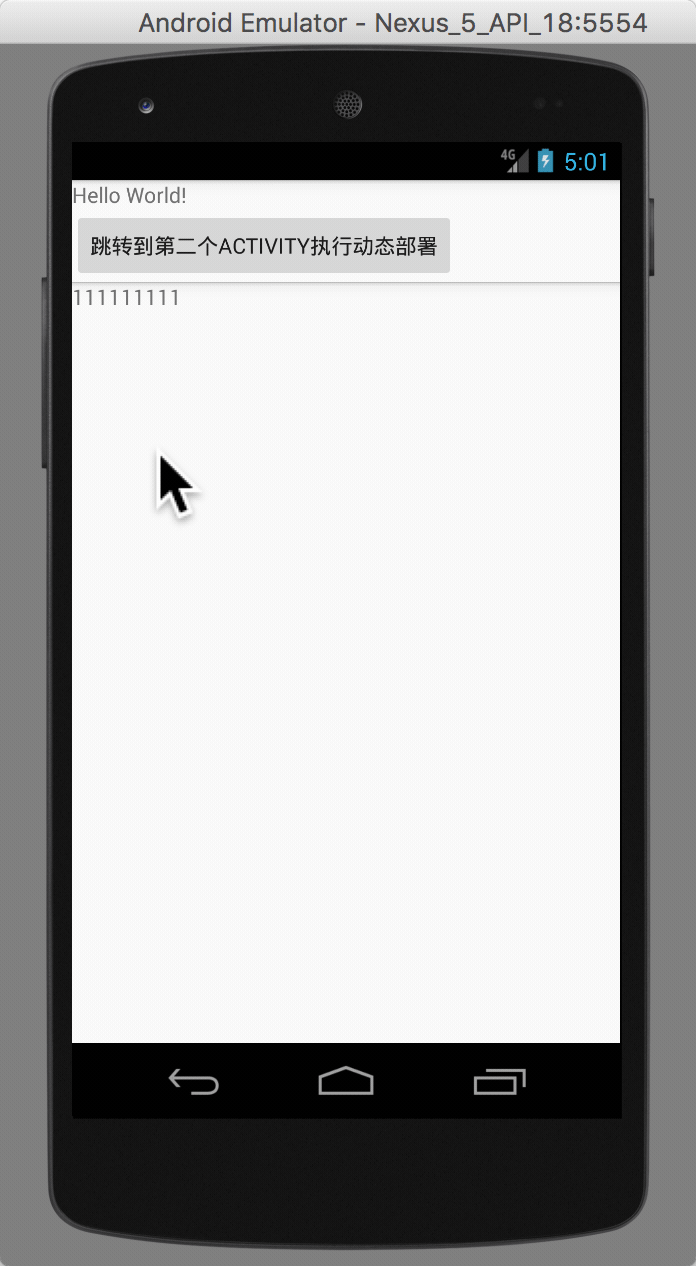概念
atlas:容器化框架,提供组件化开发,热更新。
如上图所示,atlas主要分为以下几个层级:
- 最底下的hack工具层: 包括了容器所需的所有系统层面的注入和hack的工具类初始化和校验,容器启动时先校验设备是否支持容器运行,不支持则采取降级并记录原因;
- Bundle Framework 负责bundle的安装 更新 操作以及管理整个bundle的生命周期;
- runtime层:主要包括清单管理、版本管理、以及系统代理三大块,基于不同的触发点按需执行bundle的安装和加载;runtime层同时提供了开发期快速debug支持和监控两个功能模块。从Delegate层可以看到,最核心的两个代理点:一个是DelegateClassLoader:负责路由class加载到各个bundle内部,第二个是DelegateResource:负责资源查找时能够找到bundle内的资源;这是bundle能够真正运行起来的根本;其余的代理点均是为了保证在必要的时机按需加载起来目标bundle,让其可以被DelegateClassloader和DelegateResource使用
- 对外接入层:AtlasBridgeApplication是atlas框架下apk的真正Application,在基于Atlas框架构建的过程中会替换原有manifest中的application,所以Atlas没入的接入并不存在任何初始化代码,构建脚本完成了接入的过程。AtlasBridgeApplication里面除了完成了Atlas的初始化功能,同时内置了multidex的功能,这样做的原因有两个:
很多大型的app不合理的初始化导致用multidex分包逻辑拆分的时候主dex的代码就有可能方法数超过65536,�AtlasBridgeApplication与业务代码完全解耦,所以拆分上面只要保证atlas框架在主dex,其他代码无论怎么拆分都不会有问题;
如果不替换Application,那么atlas的初始化就会在application里面,由于基于Atlas的动态部署实际上是类替换的机制,那么这种机制就会必然存在包括Application及其import的class等部分代码在dalvik不支持部署的情况,这个在使用过程中造成一定成本,需要小心的使用以避免dalivk内部class resolve机制导致部分class没成功,替换以后该问题得到最好的解决,除atlas本身以外,所有业务代码均可以动态部署;
另外内置的原生的multidex在dalvik上面性能并不好,atlas内部对其进行了优化提高了在dalvik上面的体验。
除AtlasBridgeApplication之外,接入层对外提供了部分工具类,包括主动install bundle,start bundle,以及获取全局的application等各种功能。
集成
-
工程项目的build.gradle文件依赖插件:
-
app目录下的build.gradle使用插件,并且添加相关依赖
加载自启动的bundle
switchToActivity("home","com.taobao.firstbundle.FirstBundleActivity");
//通过类名来调用
public void switchToActivity(String key,String activityName){
Intent intent = new Intent();
intent.setClassName(getBaseContext(),activityName);
activityGroupDelegate.startChildActivity(framelayout,key,intent);
}
可以看到现在的fistBundle中弹出了一个toast,message 为“更新一下”,下面修改firstBundle中的代码,然后热更新一下
修改toast的message
@Override
protected void onResume() {
super.onResume();
Toast.makeText(this, "单模块部署1111111", Toast.LENGTH_SHORT).show();
}
bundle热更新步骤
1、 app的build.gradle的语句"version = getEnvValue("versionName", "1.0.0");"中修改想要生成的app的versionName(默认为1.0.0)
app目录下执行../gradlew clean assembleDebug publish
(生成apk同时将跟apk同目录的ap文件发布到仓库)
2、 手机上安装apk,同时进到动态部署界面(侧边栏里面划开点击进入),且手机连接电脑adb(确保adb devices可见)
///////////////////////////////^^^^^^准备工作^^^^^^^^^////////////////////////
3、 进行一些想要的修改(暂时不支持manifest的修改,会在近期上线)
4、 app工程目录下执行../gradlew clean assembleDebug -DapVersion=apVersion -DversionName=newVersion,
其中apVersion为之前打的完整apk的版本,newVersion为此次动态部署要生成的新的版本号
5、 检查build/output/tpatch-debug 目录下文件是否生成,然后执行下面的命令(以下为mac下的命令,windows请修改文件分隔符)
adb push build/outputs/tpatch-debug/update.json /sdcard/Android/data/cx.com.atlasdemo11111/cache/update.json
adb push build/outputs/tpatch-debug/patch-*.tpatch /sdcard/Android/data/cx.com.atlasdemo11111/cache
6、 点击动态部署页面红色按钮执行动态部署
更改firstBundle中的代码,然后
在app目录下执行命令,app/build/outputs/ 会出现
//DapVersion基准版本号 DversionName更新版本号
../gradlew clean assembleDebug -DapVersion=1.0.0 -DversionName=1.0.1
命令跑完后就会出现下面的目录结构
执行
adb push build/outputs/tpatch-debug/update.json /sdcard/Android/data/cx.com.atlasdemo11111/cache/update.json
adb push build/outputs/tpatch-debug/patch-*.tpatch /sdcard/Android/data/cx.com.atlasdemo11111/cache
然后点击动态部署按钮,效果如下
可以看到热更新已经成功。
远程bundle使用
- 远程bundle必须在gradle中配置,如上图
atlas {
atlasEnabled true
tBuildConfig {
autoStartBundles = ['com.taobao.firstbundle'] //自启动bundle配置
outOfApkBundles = ['remotebundle']//配置远程bundle
}
manifestOptions{
addAtlasProxyComponents true
}
patchConfigs {
debug {
createTPatch true
}
}
buildTypes {
debug {
if (apVersion) {
baseApDependency "com.taobao.android.atlasdemo:AP-debug:${apVersion}@ap"
patchConfig patchConfigs.debug
}
}
}
}
2.在Application中添加安装远程bundle的回调
Atlas.getInstance().setClassNotFoundInterceptorCallback(new ClassNotFoundInterceptorCallback() {
@Override
public Intent returnIntent(Intent intent) {
final String className = intent.getComponent().getClassName();
final String bundleName = AtlasBundleInfoManager.instance().getBundleForComponet(className);
if (!TextUtils.isEmpty(bundleName) && !AtlasBundleInfoManager.instance().isInternalBundle(bundleName)) {
//远程bundle
Activity activity = ActivityTaskMgr.getInstance().peekTopActivity();
File remoteBundleFile = new File(activity.getExternalCacheDir(),"lib" + bundleName.replace(".","_") + ".so");
String path = "";
if (remoteBundleFile.exists()){
path = remoteBundleFile.getAbsolutePath();
}else {
Toast.makeText(activity, " 远程bundle不存在,请确定 : " + remoteBundleFile.getAbsolutePath() , Toast.LENGTH_LONG).show();
return intent;
}
PackageInfo info = activity.getPackageManager().getPackageArchiveInfo(path, 0);
try {
Atlas.getInstance().installBundle(info.packageName, new File(path));
} catch (BundleException e) {
Toast.makeText(activity, " 远程bundle 安装失败," + e.getMessage() , Toast.LENGTH_LONG).show();
e.printStackTrace();
}
activity.startActivities(new Intent[]{intent});
}
return intent;
}
});
3.把app/build/outputs/remote-bundles-debug/libcom_taobao_remotebundle.so 放到sd卡的cache目录,执行命令
adb push build/outputs/remote-bundles-debug/libcom_taobao_remotebunle.so /sdcard/Android/data/cx.com.atlasdemo11111/cache/libcom_taobao_remotebunle.so
点击添加远程bundle看效果
可以看到已经将远程bundle加载成功。
在自己集成的demo中也有很多的坑。跑命令失败的情况。记录一下
集成atlas时的坑
- app工程目录下执行../gradlew clean assembleDebug -DapVersion=apVersion -DversionName=newVersion
这个命令中的apVersion必须是存在的版本号,比如在gradle中设置的1.0.0,不然会报找不到依赖
android {
compileSdkVersion 25
buildToolsVersion "25.0.3"
defaultConfig {
applicationId "cx.com.atlasdemo11111"
minSdkVersion 15
targetSdkVersion 25
versionCode 1
versionName version //这里的versionName要和脚本中的一致,如果设置死,在热修复merge的时候不会起作用
testInstrumentationRunner "android.support.test.runner.AndroidJUnitRunner"
}
buildTypes {
release {
minifyEnabled false
proguardFiles getDefaultProguardFile('proguard-android.txt'), 'proguard-rules.pro'
}
}
}
3.这个版本的单模块调试模拟还不稳定
atlas不得不说是良心之作,这个demo只是简单地集成,以供参考。
点击下载代码
官方链接







